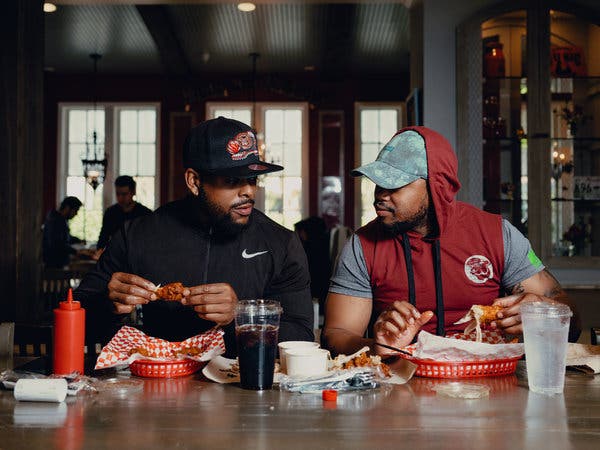LOS ANGELES — At the bar, a man insisted on Hotville’s hottest level of hot chicken (“Nashville hot”), though he hadn’t tasted medium or even mild before. The cooks had seen this a hundred times, and when the chicken came out — a large, gleaming quarter of a bird — a teasing call came from the kitchen: “Hot enough for you?”
The man couldn’t talk, but he nodded hard and flashed a thumbs-up.
Hot chicken, in its ideal form, is fried chicken in which hotness is inextricable from chickenness. The heat level varies and may be achieved with a sludge of cayenne, or a measure of ghost pepper, but it’s usually tempered by softer spices and a bit of sweetness.
In Los Angeles, the dish often takes the form of fat chicken tenders, or tenders padded out in sandwiches, but the most traditional way to eat it is on the bone, with a slice or two of soft bread and some pickles.
Breast and wing, thigh and drum, you work your way around the meat so the seasoning grazes your lips and stains your cuticles and clothes, and leads to a kind of breathless, full-body high.
Kim Prince, who opened Hotville in December, has run a hot chicken popup in Los Angeles for the last two years. She comes from the Nashville family responsible for the dish and grew up working at Prince’s Hot Chicken.
Her chicken is brined, floured and fried. She wouldn’t say much more. “The method,” Ms. Prince hesitated, “that’s something we don’t talk about.”

But the result is juicy, seasoned to the bone, crisp and crimson. Hot fish is on the menu, too, with a few sides. The beans may seem too sweet before the chicken, but they’ll be a relief afterward. And the mac and cheese has a browned, cheesy top that cooks are careful to spread out evenly among orders — a tiny gesture of fairness that I deeply appreciate.
Ms. Prince and her staff greet every diner warmly and immediately at the counter, handing them small menus printed on church fans, telling them about the poundcake and Key lime pie, and often apologizing because waffles are only available on weekends.
Hotville also offers an extra-hot chicken, off the menu, for thrill seekers. “But I try to talk people off that ledge,” Ms. Prince said. “I think it’s pure punishment and pain.”
All of the food travels well. The chicken holds its texture for some time, and the bread tends to soak up excess drips. But if you’re driving your order home, the slight tilt and shake of the car can pool the fat dangerously into the corner of a leaky box. My passenger seat is stained with oil.
So eat it there. There’s plenty of parking, and the chicken, which takes a little time as it’s fried to order, tastes better as soon as it’s made. The dining room is big and comfortable, with college basketball often playing quietly on the screen above the bar.
The city was already rich with hot-chicken restaurants when Ms. Prince opened hers, on the edge of the Baldwin Hills Crenshaw mall.
Howlin’ Ray’s, which started as a truck, now has absurdly long lines for its excellent chicken, twisting through Far East Plaza in Chinatown. Hawaiian Hot Chicken, one of several businesses that operate out of a carwash in the San Fernando Valley, stuffs tenders into shiny Hawaiian buns, giving it a distinctly Angeleno feel.
There are too many others to list. Did Los Angeles need another?
Yes. Hotville connects them all, drawing a straight line east to Nashville, back into the 1930s when Thornton Prince III — Ms. Prince’s great-great-uncle, a farmer with a side hustle, and the architect of hot chicken as we know it — sold the dish out of his house.
Mr. Prince’s hot chicken was viciously hot, fried in cast-iron skillets. It was difficult to take just one bite, even if that bite stung a little, and you could suddenly feel the pulse of blood in your lips. Even if you sniffled like a baby with a cold, you went back for more, because it was so good.
Eventually Mr. Prince opened a small restaurant. His grandniece, André Prince Jeffries, has run the business in Nashville since the 1980s. (“The women in the family have always carried the business forward,” Ms. Prince said.) But despite the secrecy of the family’s technique and the deliciousness of its mythology, hot chicken grew into an icon, claimed and modified and adored by cooks from all over.
At Hotville, there’s a fuzzy black-and-white image of the Princes on the wall, taken in 1916 at the family homestead in Williamson County, Tenn.
Ms. Prince remembers being a girl of about 7 or 8, helping out at the restaurant. “I started as a pickle girl,” she said. She would pull pickles from buckets all day, and go home with fingertips tinted green, the smell of dill and brine in her skin.
Sure, once a year, every year, someone at a food publication will declare this the Year of Hot Chicken. But eat at Hotville, and it’s clear that 2020 won’t be, and frankly neither was 2019, or 2018, because the thing about hot chicken is that it doesn’t have a year.
Hot chicken is canon. Hot chicken is a timeless, boundless, endless source of pleasure, and it’s been sustained by the Prince family for decades.
It’s not having a moment, because a moment suggests an ending, and hot chicken doesn’t end, it only begins, again and again and again, with someone’s first crunch into chile-stained chicken and a cook calling out from the kitchen: “Hot enough for you?”
Follow NYT Food on Twitter and NYT Cooking on Instagram, Facebook, YouTube and Pinterest. Get regular updates from NYT Cooking, with recipe suggestions, cooking tips and shopping advice.



